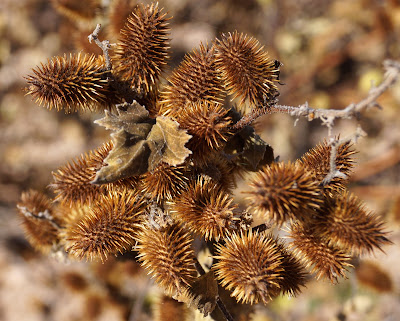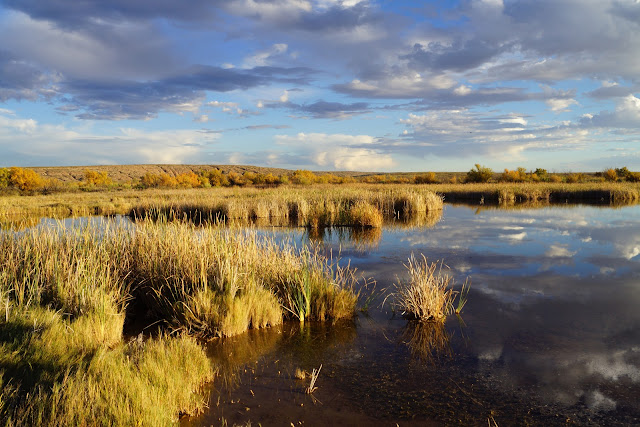We woke up to a very cold morning, for the first time in weeks. So we bundled up and headed south to the New Mexico-Texas border in what must be the foothills of the Guadalupe Mountains. They didn't seem quite like mountains. You have to drive through them a ways before you get to the Cavern entrance.
Visitors have the choice of many tours, but several folks over the past few days had recommended that we take the Natural Cavern Entrance and Big Room self-guided tours. So we did. In the caves it stays about 58 degrees all the time. So we were already dressed appropriately for the chill.
First stop is the Visitor's Center where we picked up a couple of audio tours. They worked really well and we were glad we got them. This is the only cave I've ever been in where you could walk through by yourself without a gang of people led by a ranger telling goofy stories. Once out of the Visitor's Center we passed through the Wildlife Amphitheater before starting the descent. This is where people watch thousands of bats leave the cave in the evening. This only happens in the warmer months, so the bats have already flown south. (In fact, I overheard some visitors talking to a ranger who said they had all pretty much left just the night before. The bats knew it was going to get cold I guess.)
Then the long trail down begins, and it goes on for a very, very, very long way. It takes about an hour and a half just to get down all the countless switchbacks to the Big Room, and there is so much to see every step along the way.
The trail down is almost enough by itself, and it's more than I've seen in any other cave. Here's a shot looking back up through the opening.
The last of the natural light fades...
The cave is lighted with theatrical lights that are subtle yet effective. It used to be "in" to light caves with boldly colored lights, name the features fancifully, and even to add cute little trolls and gnomes to the landscape. You can still find caves like that in this country. Now the national parks try to provide just enough light so that visitors can see the most interesting formations while still giving the essential feeling of being in a cave, which is a very dark place. To us it usually just looked like dim warmish light, but the camera picked up more obvious shades of green and gold in addition to white.
The entrance flattens out...
Formations begin to appear...
And it keeps going down!
We weren't sure we were going to be able to get pictures at all, but I think our cameras did really well. The cave is too big for a flash to be effective. Here's what happens. The foreground gets washed out and the background is blurry.
The rock formations as a whole are called speleothems. The types in this cave are stalagmites, stalactites, popcorn, columns, soda straws, flowstone, draperies and many combinations of them all. This a close up of some draperies.
These are very thin draperies lighted from behind, called the "Whale's Mouth."
This is popcorn...
And this is a combination of speleothems.
This is a close up of a small portion of about a 20 foot column.
There are no significant crystal formations in these caves, but in an adjacent cave system (where no one is allowed but researchers) there are massive crystals of several kinds.
Once the descent of the entrance trail is complete, visitors are directed to a concession and rest area, thank goodness, because by that time we were glad there were restroom facilities in the cave. The overall effect is kind of Disneyworld meets Edward Hopper's Nighthawks.
Here's this hybrid entrance to the restroom.
So, on to the Big Room. The pictures do not do justice to how big it really is. They say it is the size of 6.2 football fields. You can see the silhouettes of two people on the far left. By the way, we encountered only about ten people in 4-5 hours.
All around in every direction there are formations (also called decorations), large and small adjacent grottos, holes going up, holes going down, passages going every which way. The cave and all the formations are formed by water, which still runs through the cave, meaning that it is a "living" cave or still forming. There are some small reflecting pools on the cave floor, but the water level fluctuates in response to the amount of water coming down from the surface.
Visitors must stay on the paths. No problem. The paths are really smooth and there are always railings to hang on to. Other parts of the caverns that can be reached on other tours are not so easy to traverse.
This picture is looking up at delicate stalactites forming along cracks in the ceiling.
This section is called "Fairyland:"
More columns and stalactites...
I tried to capture it from every angle. In this picture you may also get a sense of how densely the speleothems have formed on all surfaces of the cave.
This massive stalagmite is called the "Rock of Ages."
By this time we were feeling kind of aged ourselves, and saturated enough with caveness.
By this time we were feeling kind of aged ourselves, and saturated enough with caveness.
But there was still more...
This miniature grotto is called the "Doll's Theater." It really is doll sized.
And this formation didn't have a name, but I think it looks like an evil troll,
so here's wishing you, dear reader...
a Happy Halloween! See you in Texas!





















































